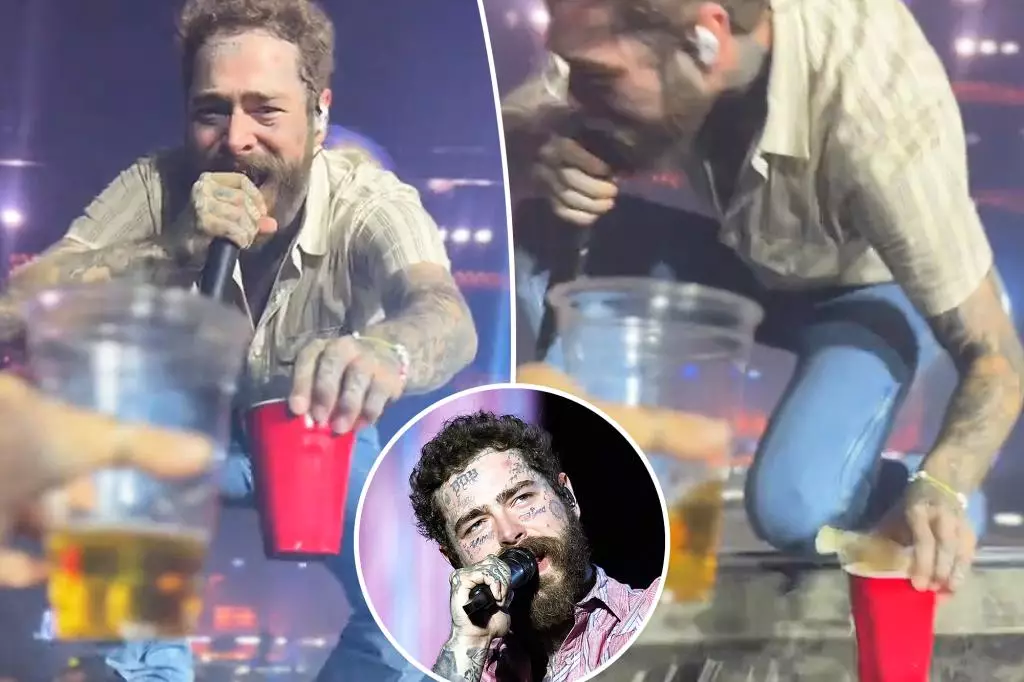In recent years, the image of the flawlessly polished pop star has been challenged by candid moments of vulnerability—moments that reveal the human behind the celebrity. Post Malone’s accidental fall during his concert exemplifies this phenomenon, highlighting both the perils of live performances and the unexpected moments that forge a deeper connection between artists and their audiences. While such incidents might seem trivial or embarrassing, they serve as profound reminders that even the most successful performers are susceptible to mistakes, emphasizing the importance of resilience and authenticity.
Malone’s stumble during his Glendale show, triggered by a stage platform inexplicably giving way as he attempted to engage with fans, underscores the risks inherent in high-energy, theatrical live performances. It also exposes the often-overlooked design flaws of concert stages—areas that may not be sufficiently secure to withstand the spontaneity of an artist’s interactions. This incident prompts industry insiders and fans alike to question stage safety standards and the oversight involved in crafting these ephemeral entertainment environments. More than a mere spectacle, the fall becomes a case study in the importance of rigorous safety protocols, reimagined with artist well-being front and center.
However, what truly makes Malone’s response noteworthy is his refusal to let the mishap define him. After the fall, instead of succumbing to injury or embarrassment, he quickly retook control, showing a level of grit that fans admire. His ability to handle adversity on stage—an arena often marked by confidence and charisma—demonstrates the importance of mental toughness in performing arts. It also reinforces the notion that even amidst chaos and unforeseen accidents, professionalism and perseverance are vital traits for sustaining a successful career.
Public Reactions and the Power of Authenticity
The digital age has revolutionized the way fans interact with their idols, transforming every stumble or slip into an opportunity for authentic engagement. Malone’s fall sparked an outpouring of concern and support on social media, illustrating how vulnerability can humanize celebrities and foster genuine loyalty. Fans expressed genuine worry for his safety, with many emphasizing that such incidents would likely linger in their minds, not as failures but as relatable human moments.
This candid display of imperfection also breaks conventions of polished perfection that often dominate celebrity culture. Malone’s quick acknowledgment of his pain and gratitude for his fans’ patience showcases a compelling mix of humility and resilience. His post-event transparency—sharing that he was bruised but determined to continue—reinforces a critical lesson: vulnerability, when handled with honesty, can deepen an artist’s connection with their audience far more than manufactured perfection.
The incident encourages artists across genres to embrace imperfections as part of their narrative, fostering a culture where authenticity is prized over image. It sets a precedent that setbacks, when faced head-on and openly, can reinforce an artist’s relatability rather than diminish their appeal. Malone’s response is a testament to the power of vulnerability in building a resilient public persona that values perseverance as much as talent.
Lessons from Past Incidents and the Need for Better Safety Measures
Malone’s stage fall wasn’t an isolated incident; history offers numerous examples of performers encountering hazards during live shows. His previous injury in St. Louis, caused by an uncovered hole, underscores the longstanding dangers of stage design lapses. Despite the professional oversight, such accidents reveal systemic issues that demand urgent attention from concert producers and safety regulators.
While the artist’s response model—gracious, gritty, and committed to continuing—demonstrates admirable strength, it also shines a spotlight on preventable hazards. Ensuring stage safety should be non-negotiable, especially in large-scale tours that involve complex setups and energetic performances. Producers and event organizers must prioritize comprehensive risk assessments, rigorous safety checks, and innovative stage designs that respect both artist and audience safety without detracting from the spectacle.
Furthermore, Malone’s willingness to openly discuss his injuries and reassure fans exemplifies the importance of transparency. Fans appreciate honesty and are increasingly supportive of artists who demonstrate resilience and humility. Yet, this should not overshadow the broader industry responsibility to prevent such incidents altogether. The focus must shift from reactive responses to proactive safety enhancements, cultivating an environment where artist well-being is prioritized above all else.
Malone’s experiences serve as a wake-up call—bearing in mind that public vulnerability is different from neglect. The paradox remains: the very nature of live performance demands risking safety for entertainment, but it also offers an opportunity to reevaluate and improve those risks with better planning. This lessonsheet is clear—fame and excitement should never come at the expense of security, and the music industry should echo this truth before tragedy strikes again.
—
This analysis illuminates how Post Malone’s stage mishaps, rather than mere accidents, symbolize broader themes of resilience, transparency, and the urgent need for safer performance environments. These moments, while uncomfortable, can catalyze positive change in a high-stakes industry that often champions perfection over protection.

Leave a Reply